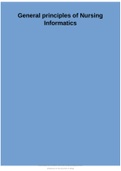Essay
Essay Unit 1 - Exploring Business P1,P2,M1,M2,D1 and D4 Graded
- Module
- Unit 1 - Exploring Business
- Institution
- PEARSON (PEARSON)
p1- Contrasting the Features of Sainsbury’s and British Heart Foundation. p2- influence of stakeholders m1 - The Relationship and Communication between Stakeholders at Sainsbury and British Heart Foundation m2 - achieving aims and objectives can contribute to the success of Sainsbury’s and B...
[Show more]












